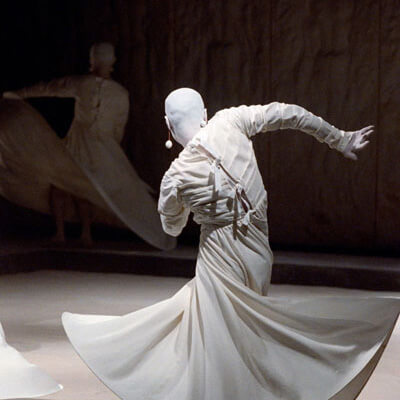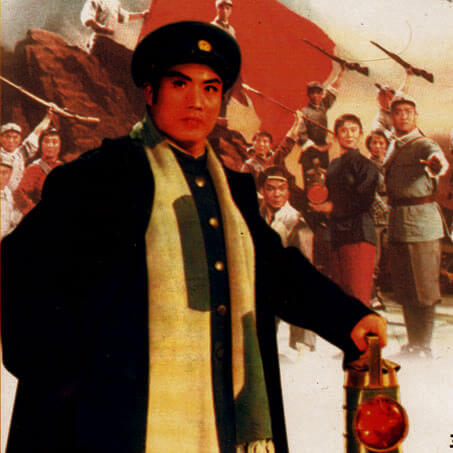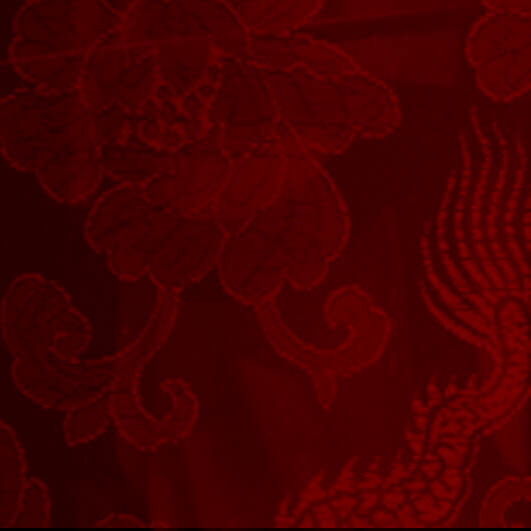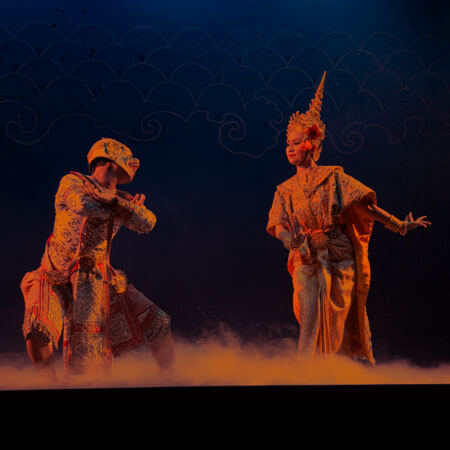Dance and Theatre in the History of Japan
The earliest archaeological evidence that is related to performing arts in Japan comes from the Yamato period (300–710 AD). Excavated objects include miniature instruments, masks, and ornaments. Clay figurines, called haniwa sculptures, include representations of dancers. The tradition of the earliest dances that are still performed, the kagura dances, stems from this period. The Creation […]
Kagura, Sacred Shinto Dances
The still thriving tradition of archaic kagura (god-performance) dances is deeply related to Japan’s earliest belief system, Shinto. Once strictly a form of ceremonial art, kagura has evolved into various forms over the course of a thousand years. Some of these forms are still related to Shinto shrines, and some to court practices, while many […]
Gigaku, Buddhist Mask Theatre
Gigaku was a form of Buddhist processional dance drama, which reached Japan in the 7th century from Central Asia through Korea and China. Gigaku blended religious themes with comedy, and even burlesque scenes, while the performances took place in temple courtyards. Its performance tradition died out in the Heian period (794–1192). Wooden gigaku masks are […]
Bugaku, Ceremonial Dances
Bugaku refers to a group of ceremonial dances, performed both in temples and at the imperial court. The dances were originally adopted from China and Korea in the 7th and 8th centuries and they were further refined during the next two centuries. They are still performed both in the temple context and in court festivities, […]
Noh, Crystallised Aesthetics
Video clip: A scene from the play Hagoromo, “The Feather Mantel”, which falls into the category of Wig Plays. Its shite represents a heavenly maiden who descends to earth. To get back her wings, or the feather mantle, she performs a heavenly dance Veli Rosenberg Noh (no) is regarded as one of the great classical […]
Kyogen, Farces about Human Life
The short farces that are performed between the serious noh plays are called kyogen. Together, these two art forms are called nohgaku. Both forms have a lot in common. Both are performed on the same stage; in both forms all the actors are men, while they are both highly stylised in their styles of acting. […]
Bunraku, an Exceptional Symbiosis of Puppetry, Storytelling and Music
Bunraku, a form of puppet theatre, created during the early Edo period (1603–1868), is without doubt the most spectacular tradition of puppetry in the whole world. Its puppets, approximately one meter high, are manipulated by black-robed puppeteers on a wide stage, while narrators chant the story in a highly expressive manner to the accompaniment of […]
Kabuki, Theatre as Spectacle
No other traditional form of theatre in Asia has evolved into such a grandiose stage spectacle as the kabuki theatre, which is four centuries old. As its name, kabuki (song-dance-acting), indicates, it combines various genres of dance and music while it is characterised, at the same time, by its highly exaggerated, mimetic acting style. Kabuki’s […]
The Twentieth Century
Western influence began to be felt in Japanese cultural life during the Meiji period (1868–1911), when the Japanese Empire was transformed, through the so-called Meiji Restorations, into an industrialised world power. Many aspects of Japanese society, its infrastructure, army and laws were remodelled according to Western models. The long-lasting rule of the shogunate was demolished […]
Butoh
Ballet was also among the Western forms of performing arts adopted in Japan in the early 20th century. Nowadays Japan has several ballet companies and dozens of first-class ballet dancers. Modern Western dance trends were introduced to Japan for the first time by the musician, choreographer and dancer Baku Ishii (1886–1962). He started his career […]
From East to West, from West to East — Controversies in Cultural Exchanges
by Anna Thuring Asian and Western performance cultures have interacted in multiple ways for centuries. After Western colonization of many Asian areas, their traditional theatre forms have been exploited and appropriated in the West. In the best of occasions, they have been admired and used for inspiration, in worst cases, ridiculed, censored, or used superficially. […]
White-Haired Girl
The play is based on a real incident in 1940. A “white-haired goddess” was found by Communist soldiers in a remote place. Actually, she was a village girl who had been raped by a landlord and had escaped into the mountains, where she gave birth to her child. Her constant suffering and hunger had made […]
Red Lantern
This model opera tells about three revolutionaries. The leading character is a middle-aged railway worker, Li, who earlier took part in a strike. During the strikers’ riots he adopted an orphaned young girl. Li also invites an elderly woman who became a widow during the riots to live with him. They live together like a […]
Tales of the Silk Road
The dance drama is set in the Tang Dynasty and it tells about the daughter, Yingniang, of a poor painter who works in the famous caves of Dunhuang. An evil magistrate is interested in Yingniang but a Persian merchant rescues her and takes her to Persia where she becomes familiar with local people. When she later returns […]
Snow in Midsummer
Original Manuscript: Guan Hanqing (from about 1240 to about 1320) Prelude The Wedge Video clip: Dou E. A kun-style reconstruction of 13th century play, Dou E yuan or Snow in Midsummer. Veli Rosenberg Dou E was born into a poor family. When she was three, her mother died. Because of difficulties in his life, her […]
The Floating Lady
In this episode, Totsakan (Ravana), blinded by passion, ponders how to get hold of Sida (Sita), the object of his love. The episode begins with an audience scene at the court of Totsakan, where Totsakan’s niece Benyakai claims that she can transform herself into Sida’s double and thus fool Phra Ram (Rama) and Phra Lak […]
Sang Thong
In Act One of the intricate story, the hero Sang Thong is supernaturally born in a conch shell. He is, in fact, a god incarnated in a conch shell in the womb of a childless queen. The queen’s strange childbirth is the subject of much attention at court, and an evil concubine plots with the […]
Paduma
U Pon Nya’s (1807–1866) play deals with the recurrent theme in the author’s Jataka-derived plays, the conflict between good and evil. In this play, the king is warned by his ministers that his seven sons are planning a coup, and driven by suspicion, he exiles his sons and their wives to the jungle. The journey […]
The Water Seller
A prince is returning home after completing his studies in India. Resting for a moment by the gate of his hometown, he is approached by a poor water seller, who tells him how he comes every day to the town to sell water to eke out a living. The man goes his own way, and […]
The Panji Story
Prince Panji is distressed over the mysterious disappearance of his bride Candra Kirana on the eve of their wedding. A princess claiming to be Candra Kirana arrives at his palace, but she does not look at all like her. She is, in fact, a female demon who has fallen in love with Panji. The false […]
Arjuna Vivaha
In Arjuna Vivaha, the heavenly realm of the god Indra is in a state of turmoil. A terrifying demon, who is possessed by his love for the nymph Supraba, becomes enraged when Indra refuses to give the maiden to him. A difficult situation arises, for none of the gods can beat the demon in battle, […]
The Mahabharata
The main action in the Mahabharata revolves around the legendary struggle at Kurukshetra between the Kauravas and the Pandavas over land rights. The Kauravas are the hundred sons of Dhrithrashtra, and the Pandavas, the five sons of Pandu, are their cousins. The Pandavas become the heirs to the Kuru throne, since Dhrithrashtra is blind and […]
The Ramayana
Prince Rama goes to a neighbouring kingdom to compete for the hand of Princess Sita. Being the only one able to bend the magic bow, Rama wins Sita as his bride. Rama is about to be named heir to the throne of Ayodhya, but one of the king’s wives, referring to a promise made by […]
Shakuntala
Video clip: King Dusyanta and his charioteer are out hunting; the opening scene of Shakuntala in the kutiyattam style Veli Rosenberg King Dusyanta is out hunting with his charioteer in a forest. Just when he is about to shoot a deer with his arrow a voice is heard, which forbids the king to shoot an […]
The Song of Hungbu
Nolbu, a greedy brother, seizes his father’s entire fortune and leaves his brother Hungbu in poverty. When Hungbu appeals to his brother for help in order to feed his family, Nolbu refuses to help him and accuses him of being lazy. Hungbu and his wife rescue and tenderly care for a swallow with a broken […]
Hagoromo
Video clip: A scene from the play Hagoromo, “The Feather Mantel”, which falls into the category of Wig Plays. Its shite represents a heavenly maiden who descends to earth. To get back her wings, or the feather mantle, she performs a heavenly dance Veli Rosenberg Hagoromo or The Feather Robe is one of the most […]
Aoi no ue or Lady Aoi
The play is based on a short sequence from the Genji Monogatari, or the Story of Genji, by Lady Murasaki (1004). Lady Aoi, the official wife of the handsome Prince Genji, has been taken ill mysteriously. (She is discreetly represented by a brocade robe placed in the front of the stage.) The nearly dying Lady […]
Tenko
The play is based on a Chinese legend that recounts the deeds of a youth called Tenko. He has received a supernatural drum from the heavens. The emperor wants the drum for himself but Tenko refuses and flees. Finally he is captured and drowned at sea. Once the emperor receives the drum a wonder happens: […]
Boshibari or Tied to a Pole
The wily servants Tarokaja and Jirokaja steal their master’s sake wine whenever the master is away. The master has a plan. He orders Tarokaja to tie Jirokaja’s hands and arms to a pole so that he cannot steal the sake. Then he quickly also ties Tarokaja’s hands behind his back. So the master assumes that […]
Sonezaki shinju or Love Suicides at Sonezaki
by Cikamatsu Monzaeomon (1703) A clerk from a soya sauce shop, Tokubei, is deeply in love with the courtesan Ohatsu. He has not consented to a marriage arranged by his uncle. So he must quickly return the handsome dowry given to his stepmother. He receives the money, but stupidly he lends it to his old […]
Sukeroku
1713 The main character of the play is Sukeroku, a handsome townsman of the aragoto type. He is brave, arrogant, a “chivalrous commoner” who always defeats his better samurais. He is in love Agemaki, the most celebrated courtesan of the pleasure quarter. An old samurai, Ikyo, also admires Agemaki and is very jealous of Sukeroku. […]
Burmese Music
The Burmese received instruments and other influences from India via the Mon people. Some of these instruments and forms, still employed in Burma, disappeared from India a long time ago. One example of this kind of instruments is, for example, the Burmese harp, saung gauk, regarded as the country’s national instrument. It is based on […]
Burmese Literature
The roots of Burmese literature led to indigenous folk poetry and to the basic Buddhist literature adapted through the Mons. Didactic Buddhist Jataka stories were already being written in Burmese prose in the 15th century. At the same time religious as well as historical poetry evolved, together with epistle addressed to the king. In the […]
Tai, Thai and Siamese
“Tai” refers to Tai-speaking ethnic groups, whereas “Thai” refers to the entire multiethnic population of present-day Thailand. However, many scholars prefer to use the more ethnically relaxed term “Siamese” when discussing the people of the Ayutthaya and early Bangkok period, since Thailand was formerly called Siam.
Jataka Tales
The Jataka stories refer to a large group of ancient folk tales originating from the Indian cultural sphere. They tell about the previous births of the Buddha. They are morally instructive stories in which the main character is an animal, human, or superhuman being seeking to do good. Within the Theravada Buddhist tradition they were […]
Structure of the Natyashastra
The Natyashastra consists of 36 chapters. The outer and spatial aspects, such as the stage, the theatre building etc. are discussed in Chapters 1–5. Chapters 6–7 discuss the theory of rasa, i.e. the crucial question as to how to evoke a mood, while Chapters 8–13 focus on the physical acting technique. The verbal aspect, such […]
Bharata
The person of Bharata, the supposed author of the Natyashastra, is a widely discussed topic. Some believe that the treatise is certainly the work of one writer, while it has also been argued, for example, that he is a fictitious person and that the treatise is merely a creation of the long theatrical tradition and […]
The Devadasi Institution
There was already mention of lasya-style dances in the Natyashastra, or the Drama Manual, compiled in the 2nd century AD. These dances are soft or “feminine” in style and combine abhinaya (mimetic storytelling) sequences with nrtta (pure dance) sequences. In Indian literature these dances are often related to mythical apsara nymphs, famous courtesans etc. The […]
Hindu-Buddhist Cosmology
The classical cosmologies of India’s own religions, i.e. Hinduism, Jainism and Buddhism, all started to appear after the middle of the first millennium BC. Their roots are, however, much longer and originally emerged from the more simple cosmology of the Vedic period of India (c. 1600–500 BC). The focus here will be on the Hindu […]
From Underground Art to Shiny Visions
by Ari Tenhula Butoh, a branch of Japanese contemporary dance, evolved in the late 1960s and the early 1970s during the politically stormy period of student riots, art happenings, and radical agitprop performances. Tatsumi Hijikata (1928–86) is regarded as the founder of butoh. He studied various styles and techniques, among them the German expressionistic Ausdrucktanz, […]
Role Types of the Peking Opera
by Pertti Seppälä The role categories of Chinese opera started to take their present shape during the Yuan Dynasty (1279–1368), when the first important dramas were written. These role categories were direct predecessors of the role types of the present Peking Opera. Some characters from even earlier periods are known, such as the two protagonists […]
A Concise History of Theatre in Imperial China
by Stefan Kuzay Chinese theatre and opera as we know them today only developed rather late in Chinese history, compared with the other genres of the acting profession. Nevertheless, their origins lie far back in the very early forms of religion and the first and simple forms of dance and play. Thus, as in the […]
Mei Lanfang
Mei Lanfang (1894–1961) is without doubt the most famous Peking opera actor, both in China and abroad. It was Mei Lanfang who, for the first time, brought Peking Opera to the West, and thus influenced many Western pioneers of early modern theatre. He was born into a Peking Opera actor family that specialised in the […]































